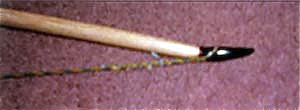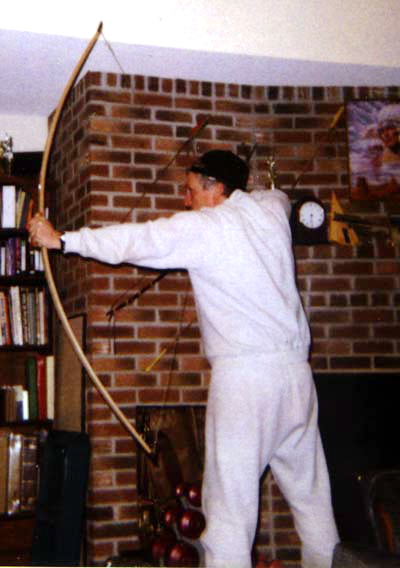
Board Bows For the length, take your draw, double it and add 20-30%. For a 26 in draw, make your bow at least 63 inches nock to nock. That is a minimum; remember that a longer bow will be more forgiving of tillering errors. On a continuum, bend in the handle bows may be shorter than handle bows. My suggestion is that if this is your first bow make it at least 68 in. long. For a beginners bow, start with a 3/4 in. board. Rings should be parallel on the sides and the back. They ideally should run the whole length of the board. However, on a plain or flat sawn board the back ring lines may come to a V. This is quite acceptable.I do like red oak boards. Also, hickory makes a great bow from a board. Other possibilities include white oak, ash, and maple. All of which I have tried and all of which make fine bows. It is important that you pick the right board; look at it closely. I'm not talking about those lines that are on the exterior but the grain lines themselves. On red oak they are brownish. Now for a 50-55 # bow you are allowed to use a board with a "few run" ups say 2 per limb. A "run up" is when the grain line goes up towards the back of the bow. This picture shows an almost perfect board. Note the straight grain with only 1 run up on the left side.

When making the bow, Be sure you round off all 4 edges with sandpaper. Measure out the center line which would be 34 in. for a 68 in. bow. Measure 2 inches on either side of that. That's your handle area. At both nocks find the center. Measure out 0.75 in. nocks. 3/8 in. on either side of center. You may also use 0.5 in. nocks if you prefer. Adjust your measurements accordingly. Find mid limb on both limbs. Draw a line from the nock to the mid limb point on both sides of that limb. Repeat on the other limb. Slowly remove wood with a draw knife (what I use) or a saw. A nice sharp hand saw would do it or a band saw. Belt sanders work fine. Power tools are best left for later, however, for the beginning bowyer. Do this on all 4 sides. You have cut out the outline of your bow. Orient the bow with the back on top. At the nock end of each limb measure down 3/8 in. Draw a line from there to the end of the handle on both limbs. Remove the wood and proceed to floor tillering stage under Bow making Directions which may be found elsewhere on this site. You will have a bow with a slightly stiffened handle section. If you want a bend in the handle bow, which is even easier to tiller, when you are laying out your bow, run the edge line right to the mid point. Once again you would measure down 3/8 in. from the nock and draw the line right to the center point of the bow on the belly side--44 in. in our example. This would produce a classic bend in the handle bow starting to bend in the handle area with the bend increasing toward the limbs. Remember to always round the edges of the board with sandpaper.
Handle bows are much easier to shoot for me. Since the handle does not bend little shock is felt when the arrow is released. Find the center. Measure 8 in. on each side for the handle. Glue on an extra 8 in.piece of a hardwood for the handle section. Shape the handle so the extra piece blends evenly to the bow. Tiller this style so that the bend starts right at the end of the handle section and increases as you go towards the nocks. The handle section may be narrowed or left 1.5 in. wide. The handle may be narrowed to 1 in to 1.25 in. if you prefer. The handle section where you hold the bow can be 4 in. long. From the end of that 4 in. on the upper and lower limbs on the back of the bow draw a line to the end of the glued piece on each side of the upper and lower limbs. These will be you fades. Remember the bend should not start until the bow begins to widen which should be at the end of the extra piece you glued. These handle bows are best left until you have made a bend in the handle bow or 2 and a slightly stiffened handle bow as I have described above. Proceed to Bow making Directions for more information. Feel free to email me your questions. This is an English longbow made from a red oak board. It is 71 inches nock to nock, has a rounded belly in the traditional style of the longbow, and horn nocks. Here is the bow braced.

Here's the horn nock on the upper limb.

Here she is at full draw.

Copyright 1999 George C Tsoukalas
